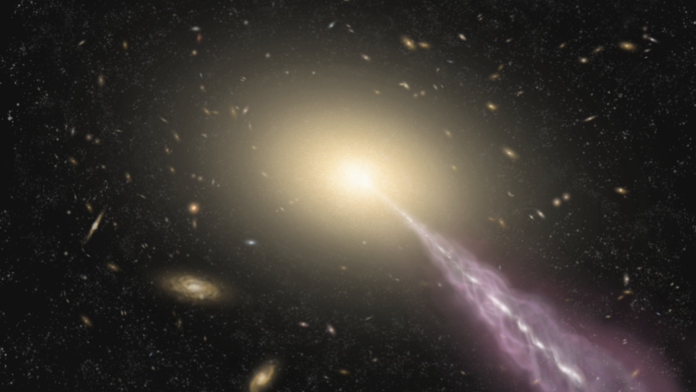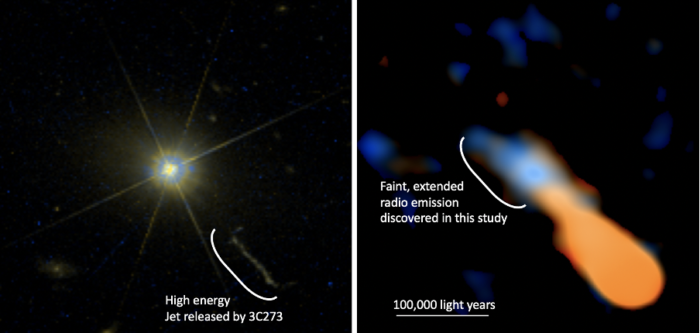Massive, unknown radio structure detected around the universe's brightest quasar
The first and brightest quasar ever discovered is still burning with secrets.

Astronomers have discovered two large, mysterious objects blasting out of the brightest black hole in the known universe.
Discovered in a 1959 survey of cosmic radio-wave sources, the supermassive black hole 3C 273 is a quasar — short for "quasi-stellar object," because the light emitted by these behemoths is bright enough to be mistaken for starlight. While black holes themselves do not emit light, the largest ones are surrounded by gargantuan swirls of gas called accretion disks; as gas falls into the black hole at near-light speed, friction heats the disk and causes it to blaze with radiation — typically detected as radio waves.
Quasar 3C 273 is the first quasar ever identified. It is also the brightest, shining more than 4 trillion times as bright as Earth's sun while sitting at a distance of more than 2.4 billion light-years away. Over the decades, scientists have studied the blazing black hole nucleus extensively — however, because the quasar is so bright, studying the surrounding galaxy that hosts it has been near impossible. That remarkable brightness has, ironically, left scientists largely in the dark about how quasars impact their host galaxies.
Now, a new study published April 28 in The Astrophysical Journal may finally change that.
Related: Distant 'quasar tsunamis' are ripping their own galaxies apart
In the study, a team of researchers calibrated the Atacama Large Millimeter/submillimeter Array (ALMA) radio telescope in Chile to separate the radiant glow of quasar 3C 273 from the light emitted by its host galaxy. They were left with just the radio-waves emitted by the quasar's galaxy — revealing two massive and mysterious radio structures never seen before.

One structure appears to be an enormous smudge of radio light that envelopes the entire galaxy, then stretches on for tens of thousands of light-years to the southwest. This radio fog overlaps with the second structure — a gargantuan jet of energy, known as an astrophysical jet, which also stretches on for tens of thousands of light-years.
Sign up for the Live Science daily newsletter now
Get the world’s most fascinating discoveries delivered straight to your inbox.
Scientists aren't exactly sure how or why astrophysical jets form. They do know, however, that jets are commonly seen around quasars and other supermassive black holes, and likely arise from interactions between a black hole and its dusty accretion disk. Jets are typically made of ionized (electrically charged) matter, and travel at near-light-speed.
The radiation released by these jets can appear brighter or dimmer depending on the radio frequency at which they're viewed — however, the large radio structure surrounding galaxy 3C 273 showed a uniform brightness, regardless of its frequency. According to the researchers, this suggests that the two radio structures are created by separate, unrelated phenomena.
After testing several theories, the team concluded that the large radio fog around the galaxy comes from star-forming hydrogen gas that's being ionized directly by the quasar itself. This is the first time that ionized gas has been seen stretching tens of thousands of light-years around a supermassive black hole, according to the researchers.
This discovery touches on a longstanding mystery within astronomy: Can a quasar ionize so much gas in its host galaxy that it prevents the formation of new stars? To answer this question, the researchers compared the galaxy's estimated gas mass to other galaxies of the same type and size. They found that, while the quasar had ionized a truly mind-boggling amount of gas, rendering it useless for building new stars, star formation was not being visibly suppressed in the galaxy overall. This suggests that thriving, growing galaxies can still exist with radiation-belching quasars at their centers.
"This discovery provides a new avenue to studying problems previously tackled using observations by optical light," lead study author Shinya Komugi, an associate professor at Kogakuin University in Tokyo said in a statement. "By applying the same technique to other quasars, we expect to understand how a galaxy evolves through its interaction with the central nucleus."
Originally published on Live Science.

Brandon is the space/physics editor at Live Science. His writing has appeared in The Washington Post, Reader's Digest, CBS.com, the Richard Dawkins Foundation website and other outlets. He holds a bachelor's degree in creative writing from the University of Arizona, with minors in journalism and media arts. He enjoys writing most about space, geoscience and the mysteries of the universe.









